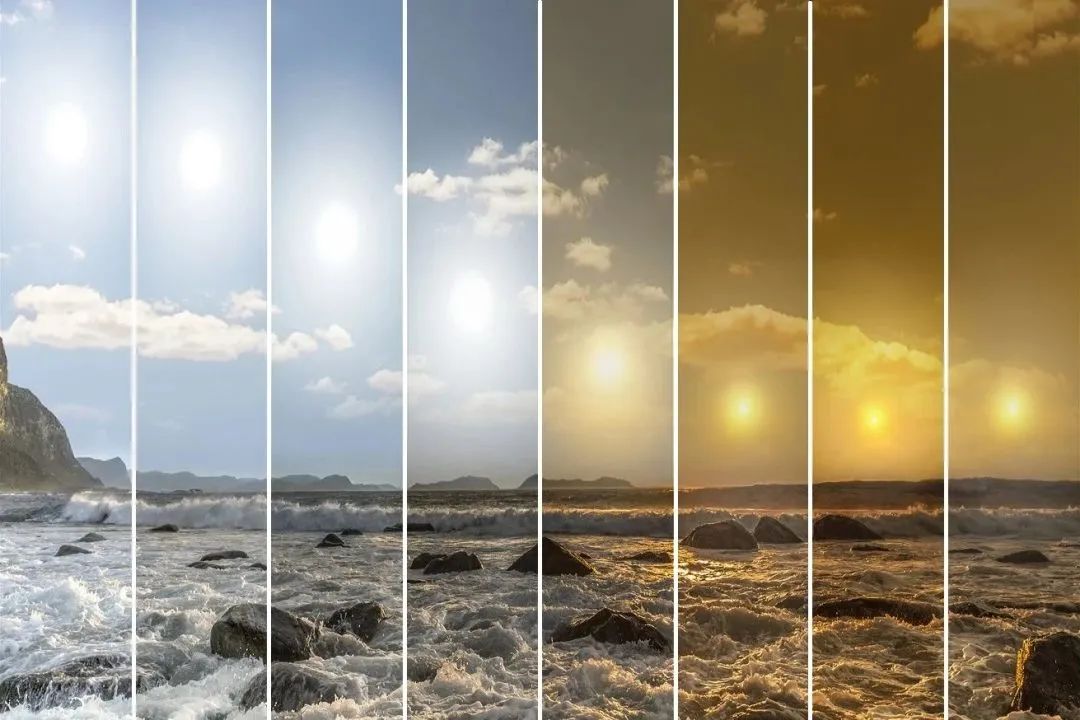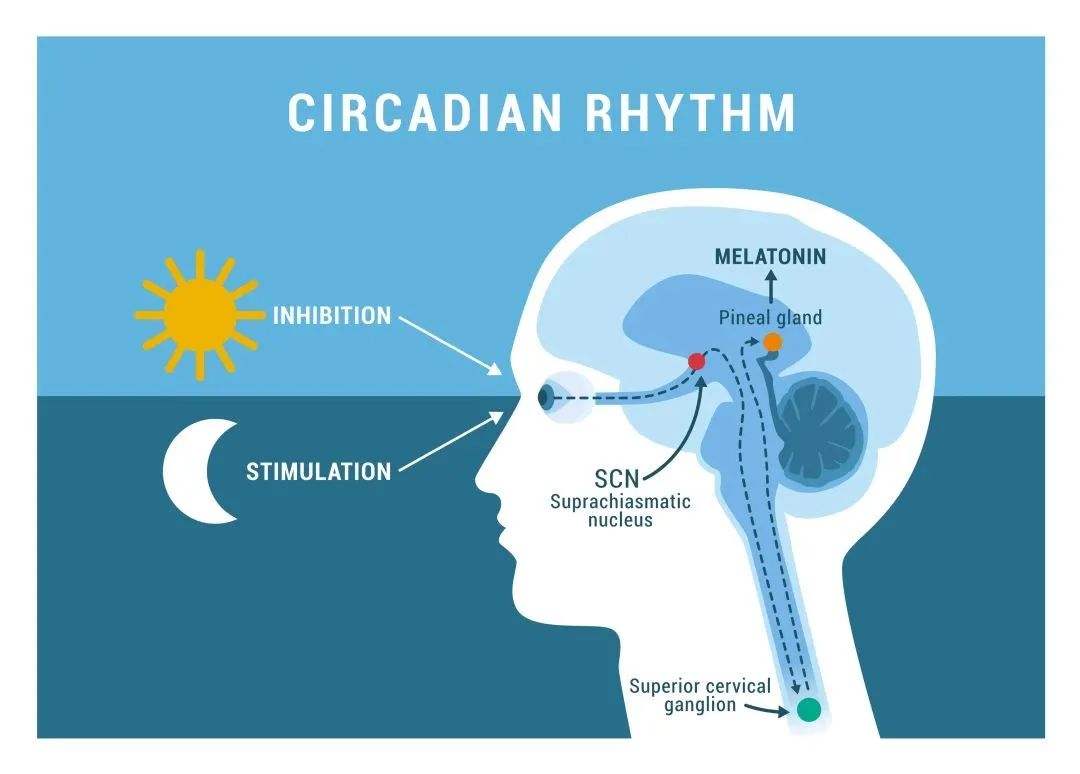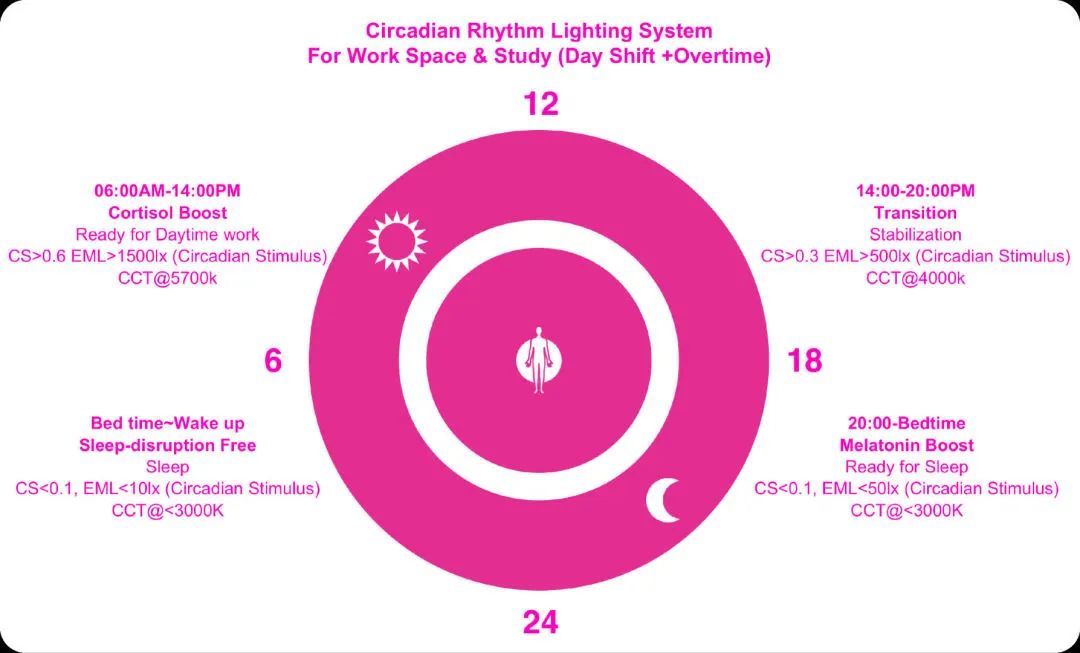I believe that every person engaged in the lighting industry have learned about the basic knowledge of color temperature: low color temperature makes people feel comfortable and warm, high color temperature is sober and exciting, in the design process will also follow this concept.
However, the real health of the light environment, not only is no glare, no strobe, only focus on illuminance, color temperature, uniformity is not enough, we also need to pay attention to the “equivalent dark pixel illuminance” value is in line with the standard.
In how to measure this value before we first recognize the concept of “melatonin”.
Melatonin
For billions of years, sunlight has served as a primordial and sole source of light that has shaped the endogenous circadian rhythms of virtually all life forms.
The reason why human beings will comply with the “sunrise to work, sunset to rest” production, life rules, because the pineal gland of the human brain will secrete a hormone: melatonin, which is a “natural sleeping pills”, is our body’s spontaneous “rest signal”. It is a “natural sleeping pill”, which is our body’s spontaneous “rest signal”. When the body has more melatonin, we will be drowsy; when the melatonin content is less, we will be energized.
And the amount of melatonin secreted is related to light intensity. Because there are autonomous photosensitive retinal ganglion cells (ipRGCs) in our retina, which can synthesize the photoreceptor protein, melanopsin, which senses the intensity of light and transmits signals to the pineal gland, thus affecting melatonin secretion: more in the dark, less in the bright light. to the pineal gland, which affects melatonin secretion: more in the dark and less in bright light. This is why it is easier to fall asleep in the dark.
Taking the earliest “artificial lighting” – firelight as an example, its color temperature was about 2000K, with very little blue light and a lot of red light. This low color temperature warm light, make people feel comfortable, can quickly enter the sleep state.
Based on this, we can review several points:
a. People need different kinds of light for different needs;
b. White light makes people awake and excited, and yellow light makes people relaxed and comfortable;
c. The essence behind is the secretion of “natural sleeping pill” melatonin;
d. Blue light stimulates “melatonin photoreceptor cells” and inhibits melatonin secretion.
These are also the physiological basis of Human Centric Lighting.
Definition and criteria for melatonin illuminance
The ladder of biological evolution is measured in hundreds of thousands of years, while the history of human civilization is less than 10,000 years. Human beings have adapted to the modern lifestyle in terms of psychological and cultural “software”, but the “hardware” of physiological structure has not kept pace with the changes. The “biological clock” in our body is such a “hardware” facility that cannot keep up with the changes. The disruption of the biological clock directly affects sleep, but also leads to poor mood, causing obesity, diabetes and other metabolic diseases.
But now want to limit the night lighting is unlikely, so we should think: what kind of light system will not cause biological clock disorder?
We wanted to design a lighting system that would provide enough stimulation during the day to keep us awake, and nighttime lighting that would satisfy visual needs without suppressing melatonin secretion too much to interfere with sleep quality.
To do this, a parameter for quantitative measurement was needed, so scientists defined this brand new illuminance value: EML (Equivalent Melanopic Lux), Equivalent Melanopic Illuminance, also known as Retinotopic Equivalent Lux.means a photometric measurement used to quantify the degree of stimulation of the photopic response of a light source to black opsins. (Definition quoted from WELL Building Standards)
Conventional illuminance lux (lx) is used to measure the light sensitivity of cone cells, quantitatively describing the light that allows the human eye to see objects.
Equivalent melanopic illuminance (EML), on the other hand, converts the spectral stimulus of a light source by weighting it by the response of ipRGCs to light as a way to quantitatively describe the biological effects of light on a person as a way of providing support for healthy circadian rhythms.
Light with higher EML increases alertness, and light with lower EML promotes the body’s melatonin secretion and decreases alertness. Therefore, no matter whether you work at sunrise or go out at daytime, you should choose the light with high EML when you work and are active, and switch to the light with low EML when you relax and before you go to bed.
The earlier published and more authoritative source for quantitative regulations on EML is the WELL Building Standard.
Measurement of equivalent melatonin illuminance level
Now that we know the role of EML and the relevant regulations, how can we know the exact EML value?
There are three ways to do this: ①measurement using a photometric instrument;②simple ratio conversion;and③precise spectral conversion.
Whether it is daily measurement, project acceptance, or convincing clients, designers need to use professional photometric instruments to test and speak with data.
In addition to the four important light indicators of illuminance, color temperature, visual contrast, and uniformity, the photometric instrument has also added the equivalent melatonin illuminance measurement, which is in line with the international WELL Healthy Building Standard™ light environment parameters, with a measurement error of <5%.
The simple ratio conversion method means measuring or calculating conventional “standard visual illuminance” values using tools such as illuminance meters, DIALux simulation software, etc. The illuminance values are then converted to EML. lx and EML conversion ratios vary for different light sources.
For example, if an incandescent lamp illuminates a space at 200 lx, the melatonin illuminance at that point is 200 x 0.54 = 108 EML.
Of course, even with similar light sources and similar color temperatures, the EML values should be different if the spectral distributions are different.
If a certain light source is not found in Table L1, how do I convert it? This is where the second conversion method comes into play: exact spectral conversion.
The relative intensity at each wavelength is first measured and then weighted with a specified formula to calculate the exact EML ratio.
For example, if I want to use BLV 4000K cup lighting in my bedroom, how much should I dim it at night?
According to the WELL building standard for bedrooms: the EML should be below 50 at night, then the illuminance in the room should be controlled below 50 ÷ 0.87 = 58 lx in the DIALux simulation.
The above is the “equivalent melatonin illuminance” of the nature, source, measurement of the content, I believe that you have a certain understanding of the human factors lighting, and then can be used in the design of this concept.
Post time: Nov-21-2023










